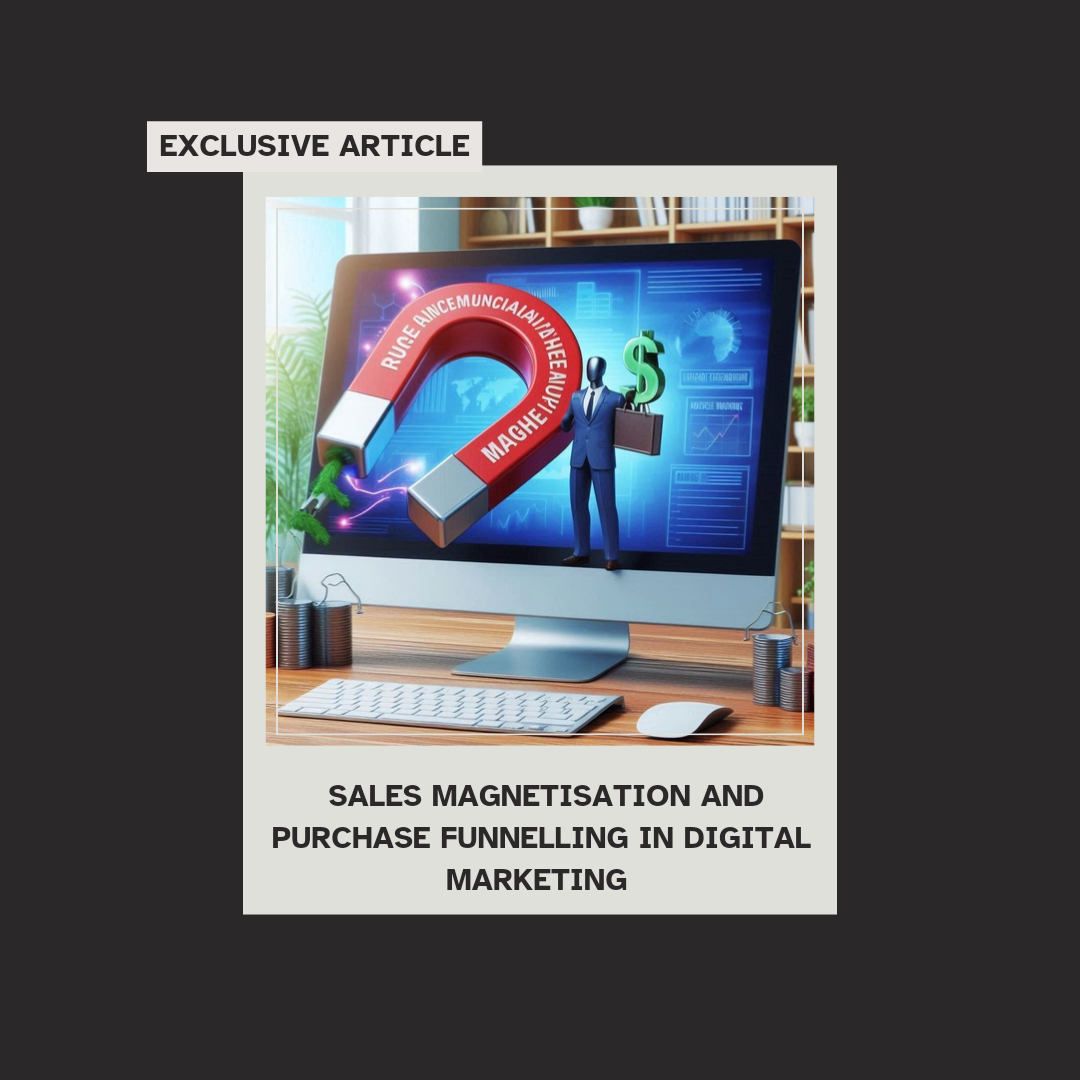Articles
Business and the Economy
EXCLUSIVE
ARTICLES
Make an impact today
Support my free content by contributing a donation.

Unleashing the Potential of Content Marketing and Branded Content
Content marketing and branded content are pivotal strategies for businesses aiming to engage consumers in today's digital landscape. By focusing on storytelling, these methods not only enhance brand visibility but also foster deeper connections with audiences. Unleashing the potential of content marketing requires a strategic approach that prioritises high-quality, relevant content tailored to the target demographic.
At its core, content marketing is about creating valuable resources that inform, entertain, or solve problems for potential customers. This could range from insightful blog posts and engaging videos to interactive infographics and podcasts. The primary goal is to establish your brand as a trusted authority within your niche, thereby driving organic traffic and customer loyalty.
Branded content, on the other hand, integrates brand values and messaging directly into the storytelling process. This form of content is designed to resonate emotionally with audiences rather than overtly promote a product or service. When executed effectively, branded content can enhance brand perception and encourage consumer advocacy, leading to increased word-of-mouth and social sharing.
To fully realise the potential of these strategies, businesses must invest in understanding their audience's preferences and behaviours. Analytics tools can provide valuable insights into what type of content performs best, allowing brands to refine their approach continually. Additionally, collaboration with influencers and content creators can amplify reach and credibility, bringing fresh perspectives that align with audience expectations.
In conclusion, the power of content marketing and branded content lies in their ability to create meaningful interactions with consumers. By focusing on quality, relevance, and authenticity, businesses can unlock new opportunities for growth, engagement, and sustainable success in an ever-evolving marketplace.

Enhancing Brand Visibility and Conversions
Enhancing brand visibility and conversions is a multifaceted approach that requires strategic efforts across various channels. To start, businesses must establish a strong online presence, utilising social media platforms, search engine optimisation (SEO), and content marketing to reach their target audience effectively. A robust SEO strategy ensures that your brand appears in relevant search results, driving organic traffic to your website.
Engaging content that resonates with the target demographic is critical. This includes blogs, videos, and infographics that address customer pain points, showcase your brand’s value, and encourage interactions. By combining educational and promotional content, brands can nurture leads and build trust with potential customers.
Moreover, leveraging data analytics is essential in understanding consumer behaviour and preferences. By analysing this data, businesses can tailor their marketing campaigns to meet the specific needs of their audience, ultimately enhancing conversion rates. Implementing A/B testing for different marketing messages allows for the optimisation of campaigns, leading to improved performance.
Finally, fostering collaboration with influencers and industry partners can significantly boost visibility. Influencers bring their own audience and authenticity, helping to amplify brand reach and credibility. When chosen carefully, these partnerships can lead to higher conversion rates as they introduce your products or services to a wider, yet targeted, audience.
In summary, enhancing brand visibility requires a comprehensive approach that marries content creation, data-driven decisions, and strategic partnerships. This not only elevates brand awareness but also sets the stage for increased conversions, driving sustainable business growth.

Effectively Utilising Product Keyword Research
Effectively utilising product keyword research is essential for optimising your online presence and enhancing your marketing strategy. By identifying the specific terms and phrases that potential customers are using in search engines, businesses can align their content and product listings with consumer intent.
Start by employing tools such as Google Keyword Planner or SEMrush to uncover high-volume keywords relevant to your products. Look for long-tail keywords, which often indicate a more targeted audience and higher conversion rates. For example, instead of focusing solely on "shoes," a more effective approach might involve "men's running shoes for flat feet." This specificity not only directs the right traffic to your site but also facilitates a clearer understanding of customer needs.
Incorporate these keywords naturally into your product descriptions, blog posts, and metadata. Engaging content that answers common customer queries can also enhance your SEO efforts, making your website a valuable resource and establishing your brand as an authority in the industry.
Regularly revisiting your keyword strategy is equally important. The digital landscape is constantly evolving, and so are consumer trends. By keeping abreast of changes in keyword performance and traffic analytics, your business can adapt accordingly, improving both search engine rankings and user engagement. In summary, a robust approach to product keyword research enables businesses to connect effectively with their audience, driving conversions and fostering long-term growth.

Unveiling the Overlapping Similarities Between Product Value Market Value
At the heart of any successful business lies the delicate balance between product value and market value. These two intertwined concepts are the driving forces behind a company's ability to thrive in the ever-evolving landscape of commerce.
Product value, the intrinsic worth of a good or service, is the foundation upon which a business is built. It is the culmination of the time, effort, and expertise invested in the creation and refinement of a product or service. This value is often reflected in the quality, functionality, and uniqueness of the offering, catering to the specific needs and desires of the target market.
On the other hand, market value is the perceived worth of a product or service in the eyes of the consumer. It is the price that the market is willing to pay for a particular item, influenced by factors such as supply and demand, brand reputation, and the overall competitive landscape. Market value is the tangible expression of a product's desirability and the consumer's willingness to invest in it.
The overlapping similarities between product value and market value lie in their symbiotic relationship. A product with high intrinsic value is more likely to command a higher market value, as it meets the needs and expectations of the target audience. Conversely, a product with a strong market value often reflects the inherent value it provides to the consumer, justifying the price point.
Successful businesses understand the importance of striking a balance between these two concepts. By continuously aligning their product offerings with the evolving needs and preferences of the market.

Sustainable Growth in the Dynamic and Competitive Digital Landscape
In today's rapidly evolving digital landscape, achieving sustainable growth is imperative for businesses looking to thrive amidst fierce competition. This growth paradigm requires a multifaceted approach that integrates innovation, technology, and strategic management to create resilient business models.
Firstly, leveraging data analytics plays a crucial role in informing decision-making processes. By harnessing big data, organisations can gain valuable insights into consumer behaviour, allowing them to tailor offerings to meet evolving market demands. This data-driven strategy not only enhances customer satisfaction but also promotes operational efficiency, thereby supporting sustainable growth.
Furthermore, embracing sustainable practices is increasingly becoming a competitive differentiation. Consumers are more inclined to support businesses that demonstrate environmental and social responsibility. Companies that integrate sustainability into their core operations can enhance their brand reputation while appealing to a conscientious customer base. This involves adopting eco-friendly technologies, optimising resource utilisation, and committing to ethical business practices, all of which can yield long-term financial benefits.
Collaboration and partnership are also essential in navigating the dynamic digital landscape. By forming alliances with other businesses, tech innovators, or even non-profit organisations, companies can access new markets and share resources, thus creating a synergistic effect that propels growth. Such collaborations can facilitate the development of new products and services that cater to diverse consumer needs, reinforcing a brand's value proposition.
In conclusion, sustainable growth in the competitive digital arena is a multifaceted endeavour that demands strategic foresight, environmental stewardship, and collaborative innovation. Businesses must adopt a holistic approach that aligns their objectives with the broader societal and ecological goals to ensure longevity and success in an ever-changing marketplace.

Understanding Niche Traffic and and Conversion Funnelling
Niche traffic refers to visitors who are specifically interested in a particular topic, product, or service. This segment of traffic is vital for businesses as it indicates a higher propensity for engagement and conversion due to the targeted nature of the audience. By focusing on a defined niche, businesses can reduce competition, tailor content directly for their audience, and consequently improve the quality of leads.
To effectively harness niche traffic, it is crucial to build a robust understanding of the audience's motivations and behaviours. This can be achieved through extensive market research, analysing industry trends, and utilising analytics tools to ascertain user preferences. Once a business identifies its niche and target audience, the next step is to implement a conversion funnel—a structured pathway guiding visitors from initial awareness to final conversion.
A conversion funnel typically consists of several stages: awareness, interest, consideration, and action. At the awareness stage, businesses must attract niche traffic through targeted marketing strategies such as content marketing, social media engagement, and pay-per-click advertising. Once traffic is attracted, the focus shifts to fostering interest through compelling content that resonates with the audience’s needs and preferences.
As potential customers progress to the consideration stage, businesses can employ tactics such as email marketing, retargeting ads, and case studies to nurture relationships and build trust. Finally, the action stage is where conversion occurs, whether that be completing a purchase, signing up for a newsletter, or requesting a demo.
Optimising each stage of the conversion funnel for niche traffic is essential, as tailoring the messaging and user experience to meet the specific needs of that audience can significantly increase conversion rates. Ultimately, understanding the interplay between niche traffic and conversion funnel dynamics allows businesses to effectively market their offerings, engage their audience, and drive growth.

Identifying Your Unique Market Proposition
Establishing a unique market proposition is a critical step in building a successful business. It involves identifying what sets your product or service apart from the competition and why customers should choose you over alternatives.
To uncover your unique market proposition, begin by thoroughly researching your industry and competitors. Analyse their offerings, pricing, target markets and marketing strategies. This will help you pinpoint gaps in the market that you can fill.
Next, reflect on your business's core strengths and capabilities. What are you uniquely positioned to provide that others cannot? Perhaps it's superior quality, innovative features, exceptional customer service or a specialised expertise. Identifying your key differentiators is the foundation of your unique market proposition.
It's also important to deeply understand your target customers - their needs, pain points, preferences and buying behaviours. How can you tailor your offering to deliver the most value to this audience? Aligning your unique strengths with your customers' priorities is the essence of a compelling unique market proposition.
Finally, craft a concise, compelling statement that communicates your unique value. This should be the cornerstone of your branding and marketing, clearly articulating why customers should choose your business. A strong unique market proposition will help you stand out, attract your ideal clients and build a sustainable competitive advantage.

Boosting Customer Satisfaction, Product Quality, and Sales Performance
In today’s competitive market, fostering customer satisfaction, enhancing product quality, and improving sales performance are intricately linked components that shape the success of a business. Organisations that prioritise these elements are better positioned to build lasting relationships with their customers and achieve sustained growth.
Understanding Customer Expectations
To boost customer satisfaction, businesses must first comprehend the expectations of their target audience. This involves more than just meeting basic needs; it requires an in-depth analysis of customer preferences, purchasing behaviours, and feedback. Regularly engaging with customers through surveys, reviews, and direct communications can provide valuable insights, allowing businesses to tailor their offerings more effectively. A proactive approach to addressing customer concerns can foster loyalty and encourage repeat purchases.
Investing in Quality Assurance
Product quality is a critical determinant of customer satisfaction. By implementing robust quality assurance processes, businesses can ensure that their offerings consistently meet or exceed industry standards and customer expectations. This can involve investing in better materials, adopting advanced manufacturing techniques, and conducting regular product testing. Training employees to maintain high-quality standards throughout the production process is equally crucial, as a well-informed workforce can significantly reduce defects and enhance overall product reliability.
Leveraging Technology for Sales Performance
To improve sales performance, businesses should leverage technology to streamline their processes. Customer relationship management (CRM) systems, data analytics, and e-commerce platforms can provide businesses with a comprehensive view of customer interactions and preferences. This information can be invaluable for personalising marketing efforts, optimising inventory management, and ultimately driving sales. Additionally, sales teams equipped with the right tools and training are more likely to engage effectively with customers, turning leads into loyal patrons.
Integrating Strategies for Holistic Growth
While customer satisfaction, product quality, and sales performance may appear as distinct areas, integrating strategies across these dimensions can yield compounding benefits. For instance, high-quality products lead to satisfied customers, who in turn become brand advocates, enhancing sales through word-of-mouth and repeat business. By viewing these elements as interconnected rather than isolated, businesses can create a cohesive approach that drives sustainable growth.
In conclusion, boosting customer satisfaction, enhancing product quality, and improving sales performance requires a multifaceted, strategic approach. By prioritising these areas, businesses can not only meet the challenges of today’s market but also position themselves for long-term success.

Building an Engaged Audience Primed for Conversion
Building an Engaged Audience Primed for Conversion
In the increasingly competitive landscape of digital marketing, establishing an engaged audience is not just a goal; it is a necessity for driving conversions. Building this audience entails more than merely collecting names on an email list; it requires strategic efforts to cultivate relationships and foster trust. Here are key strategies to effectively engage your audience and prepare them for conversion.
Understand Your Audience
The first step in engaging your audience is understanding who they are. Conduct thorough market research to identify your target demographic's needs, preferences, and pain points. Utilize tools such as surveys, social media polls, and analytics to gain insights into their behaviour. Cultivating a deep understanding of your audience allows you to craft personalized content that resonates with them on a personal level, thereby enhancing engagement.
Create Valuable Content
Once you have a clear picture of your audience, focus on creating high-quality, valuable content that addresses their specific needs. This content can take various forms, including blog posts, videos, podcasts, and infographics. The key is to provide solutions to their problems, share useful insights, and entertain them. Consistent, high-value content positions your brand as an authority in your industry, making your audience more likely to trust you and consider your products or services when they are ready to make a purchase.
Leverage Social Media
Social media platforms serve as powerful tools for audience engagement. Use these channels not only to promote your content but also to interact with your audience directly. Engage in conversations, respond to comments, and pose questions to stimulate discussion. By creating a sense of community around your brand, you increase loyalty and encourage followers to share your content, expanding your reach organically.
Foster Two-Way Communication
Engagement is a two-way street. Encourage feedback and actively seek input from your audience through comments, surveys, or focus groups. This practice not only demonstrates that you value their opinions but also gives you valuable insights into your audience's preferences. Implementing feedback can lead to a stronger connection with your audience, making them feel more invested in your brand.
Analyse and Adapt
Finally, continuously analyse your engagement efforts to determine what resonates with your audience. Use metrics such as click-through rates, shares, and comments to gauge the effectiveness of your content and strategies. Regularly adapting your approach based on performance data ensures that you remain relevant and attuned to your audience's evolving needs.
By fostering an engaged audience through these strategies, businesses can create a solid foundation that enhances conversion rates and encourages brand loyalty. In today's fast-paced digital world, the emphasis must be placed on relationships and engagement to drive sustainable growth.

Web Design and Copywriting that Converts
Web Design and Copywriting That Converts
In today’s digital landscape, a compelling online presence hinges on the harmonious integration of web design and copywriting. Both elements work in tandem to engage visitors, convey your brand’s message, and ultimately drive conversions. This excerpt explores the critical aspects of design and copy that can lead to enhanced user experience and elevated conversion rates.
The Importance of User-Centric Design
Effective web design prioritises the user experience (UX). A user-centric approach ensures that navigation is intuitive, loading times are optimised, and the overall aesthetic is appealing. Once users enter a site, they should be able to locate information swiftly without unnecessary frustration. Key design elements include:
Responsive Layouts: With an increasing number of users accessing sites on mobile devices, a responsive design adapts seamlessly to various screen sizes. This versatility improves usability and reduces bounce rates.
Visual Hierarchy: Organising elements based on their importance helps guide users’ attention. Use contrasting colours, sizes, and whitespace strategically to highlight calls to action (CTAs) and essential information.
Consistent Branding: Maintaining consistent visual branding—including colours, fonts, and imagery—across all platforms reinforces brand recognition and trust.
The Power of Persuasive Copywriting
While design sets the stage, copywriting drives the narrative. Compelling copy engages users, conveys value, and encourages them to take action. Effective strategies for persuasive copy include:
Clear and Concise Messaging: Users are often inundated with information online. Crafting clear and concise copy ensures your message is easily digestible, focusing on what matters most to your audience.
Emphasising Benefits Over Features: Instead of merely listing product features, highlight the benefits these features provide. This approach aligns your offerings with the audience's needs and desires, making your message more relatable.
Strong Calls to Action: Your CTAs should be unmistakable and persuasive. Use actionable language that spurs users to take immediate action, whether it’s “Shop Now,” “Sign Up Today,” or “Learn More.”
Conclusion
Combining effective web design with strategic copywriting creates a powerful online presence that not only attracts visitors but also converts them into loyal customers. By focusing on user-centric design principles and crafting persuasive, benefit-driven copy, businesses can enhance their digital footprints and achieve sustained growth in an ever-competitive market.

Top 10 Solutions to Address Operational Inefficiencies in Your BusinesS
Top 10 Solutions to Address Operational Inefficiencies in Your Business
Operational inefficiencies can have a significant impact on a business's bottom line, leading to wasted resources, reduced productivity, and lost revenue. To mitigate these issues, here are ten effective solutions that can transform your operations:
Implement Process Mapping
Visualising your processes can help identify bottlenecks and redundancies. By mapping out workflows, you gain clarity on the steps required to complete tasks, enabling you to streamline operations.Leverage Automation Tools
Investing in automation software can reduce manual tasks that are time-consuming and prone to error. Automated solutions for accounting, inventory management, and customer relationship management can significantly enhance efficiency.Conduct Employee Training
Regular training ensures that employees are equipped with the latest skills and knowledge. A well-trained workforce can perform tasks more effectively and with greater confidence, leading to higher productivity.Adopt Lean Methodology
The principles of lean methodology focus on eliminating waste and enhancing value. By adopting these practices, businesses can optimise their processes and create more efficient workflows.Utilise Key Performance Indicators (KPIs)
Establishing KPIs allows businesses to track performance and identify areas that require improvement. Regularly reviewing these metrics ensures that you stay aligned with your operational goals.Enhance Communication
Improving communication channels within teams can eliminate misunderstandings and facilitate quicker decision-making. Regular meetings and collaborative tools can foster a more cohesive work environment.Incorporate Agile Practices
Agile project management allows for flexibility and iterative improvements. By breaking projects into smaller, manageable tasks and continuously assessing progress, businesses can adapt more swiftly to changing needs.Evaluate Supply Chain Efficiency
A thorough analysis of your supply chain can uncover inefficiencies and areas for cost reduction. Streamlining supplier relationships and inventory management can improve overall operational performance.Solicit Employee Feedback
Employees often have valuable insights into inefficiencies they encounter daily. Encouraging feedback and suggestions can uncover issues that may not be apparent to management.Invest in Technology Upgrades
Outdated technology can hamper productivity. Assessing current systems and investing in modern solutions can enhance efficiency, facilitate better data management, and reduce operational delays.
By implementing these solutions, businesses can significantly improve their operational efficiency, ultimately leading to enhanced performance and profitability.


